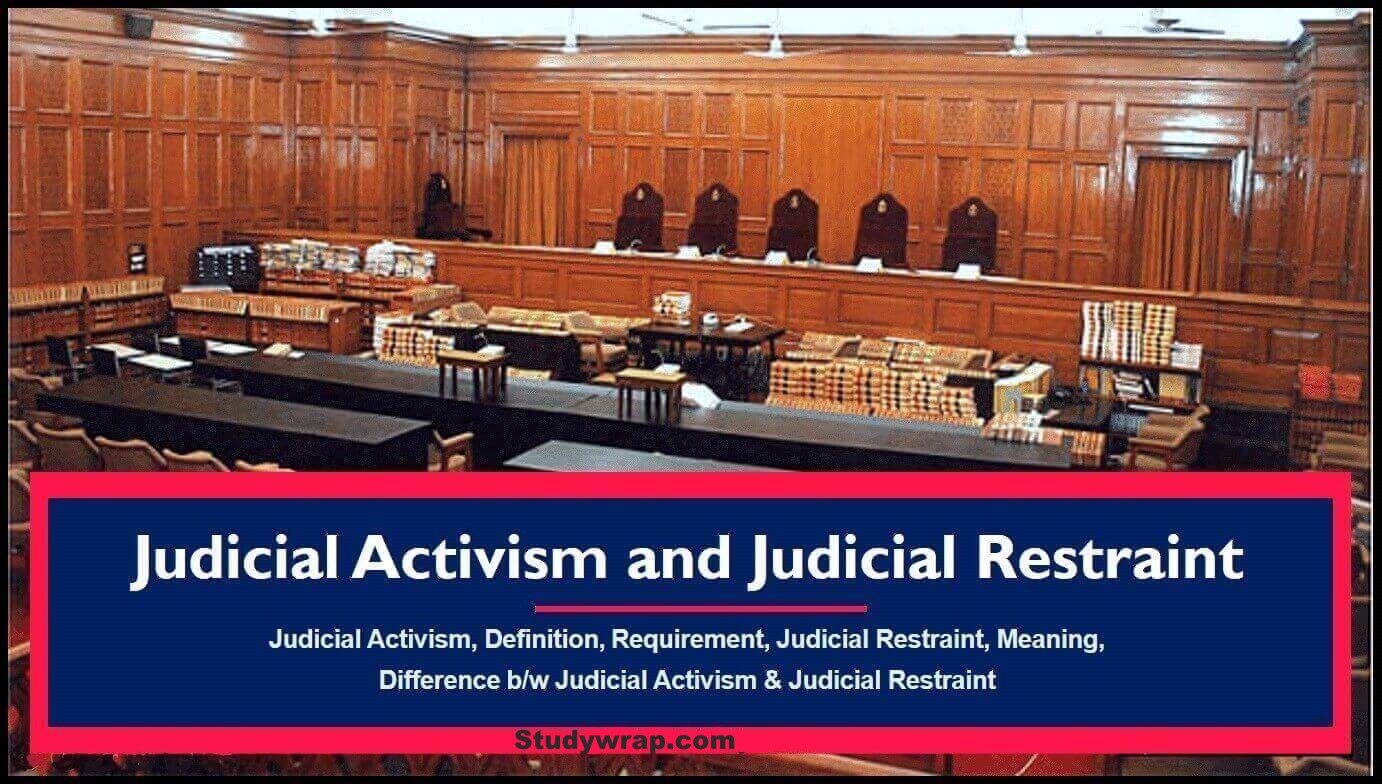Judicial Activism and Judicial Restraint
Judicial Activism
Table of Contents
· Origin – USA
· In India, it was introduced in mid 1970s by Justice V.R. Krishna Iyer, Justice P.N. Bhagwati, Justice O. Chinnappa Reddy and Justice D.A. Desai.
What is Judicial Activism?
· The assertive role played by the Judiciary in the protection of the rights of the Citizens and in promotion of justice in society is Judicial Activism.
· It can be defined as judicial decision making where by judges allow their personal views regarding a public policy instead of constitutionalism.
· Judicial Activism is the assertive role played by the judiciary to force the other two organs of the Government (Legislature and Executive) to discharge their constitutional duties.
· “Judicial activism is the practice in the judiciary of protecting or expanding individual rights through decisions that depart from established precedent, or are independent of, or in opposition to supposed constitutional or legislation intent”.
Why Judicial Activism is Required?
· The reasons and requirement for the Judicial Activism can be seen in –
1. Judicial Enthusiasm, that is, the judges like to participate in the social reforms that take place in the changing times.
2. Legislative Vacuum, that is, there may be certain areas, which have not been legislated upon.
3. There is near collapse of the responsible government, when the Legislature and Executive fail to discharge their respective functions.
4. When the legislature fails to discharge its responsibilities.
5. Where the legislature and the executive fail to protect the basic rights of citizens.
6. Where the court of law is misused by a strong dictatorial parliamentary party government for hidden motives, as was sought to be done during the emergency.
Activators of Judicial Activism
· Upendra Baxi has outlined following types of social and human rights activist who motivated Judicial Activism –
a. Civil Rights Activists – primarily focus on civil and political rights issues.
b. People Rights Activists – focus on social and economic rights within the contexts of state repression of people’s movements.
c. Consumer Rights Groups – raise issues of consumer rights within the framework of accountability of the polity and the economy.
d. Citizens for Environmental Action – activate an activist judiciary to combat increasing environmental degradation and pollution.
e. Rights of Child Groups – focus on child labour, the right to literacy, juveniles in custodial institutions and rights of children born to sex workers.
f. Custodial Rights Groups – include social action by prisoners’ rights groups, women under state ‘protective’ custody and persons under preventive detention.
g. Poverty Rights Groups – litigate issues concerning draught and famine relief and urban impoverished.
h. Indigenous People’s Rights Groups – agitate for issues of forest dwellers, citizens of the 5th and 6th Schedules of the Indian Constitution and identity rights.
i. Women’s Rights Groups – for issues of gender equality, gender-based violence and harassment, rape and dowry murders.
j. Media Autonomy Groups – focus on the autonomy and accountability of the press and instruments of mass media owned by the State.
k. Assorted Individual Petitioners – includes freelance activist individuals.
l. Assorted Lawyer-Based Groups – includes the critically influential lawyers’ groups which agitate for various causes.
Judicial Restraint
Meaning of Judicial Restraint
·Judicial Restraint is a theory of judicial interpretation that encourages judges to limit the exercise of their own power.
·It states that judges should hesitate to strike down laws unless they are evidently unconstitutional.
·It helps in preserving a balance among the three branches of government; judiciary, executive, and legislative.
·Judicial restraint is sometimes regarded as the opposite of judicial activism.
Doctrine of Judicial Restraint
· The doctrine of judicial restraint is based on following features in India –
1. Courts are undemocratic because they are non-elective and non-responsible to popular will.
2. The doctrine of separation of powers.
3. The concept of federalism, dividing powers between the nation and the states requires of the Court deference toward the action of state governments and officials.
4.The non-ideological but sensible assumption that since the Court is dependent on the Parliament for its jurisdiction and resources, and dependent on public acceptance for its effectiveness, it ought not to overstep its boundaries without consideration of the risks involved.
5. Being a court of law, and inheritor and custodian of the Constitution, Courts should not go in politics.
Difference b/w Judicial Activism & Judicial Restraint
|
Judicial Activism |
Judicial Restraint |
|
Judicial activism is the interpretation of the Constitution to advocate contemporary values and conditions. |
Judicial restraint is limiting the powers of the judges to strike down a law. |
|
In judicial activism, the judges are required to use their power to correct any injustice especially when the other constitutional bodies are not acting. |
In judicial restraint, the court should uphold all acts of the Parliament and the state legislatures unless they are violating the Constitution of the country. |
|
It has a great role in formulating social policies on issues like protection of rights of an individual, civil rights, public morality, etc. |
The courts generally defer to interpretations of the Constitution by the Parliament or any other constitutional body. |
|
It gives the power to overrule certain acts or judgments. |
It encourage reviewing an existing law rather than modifying the existing law. |
So, this was all about the Judicial Activism and Judicial Restraint. You can read about Salient Features of Indian Constitution here.
In the Next Post (Click Here), we will study in detail Public Interest Litigation (PIL). If you liked the article than do subscribe our Facebook page, to get regular updates.


